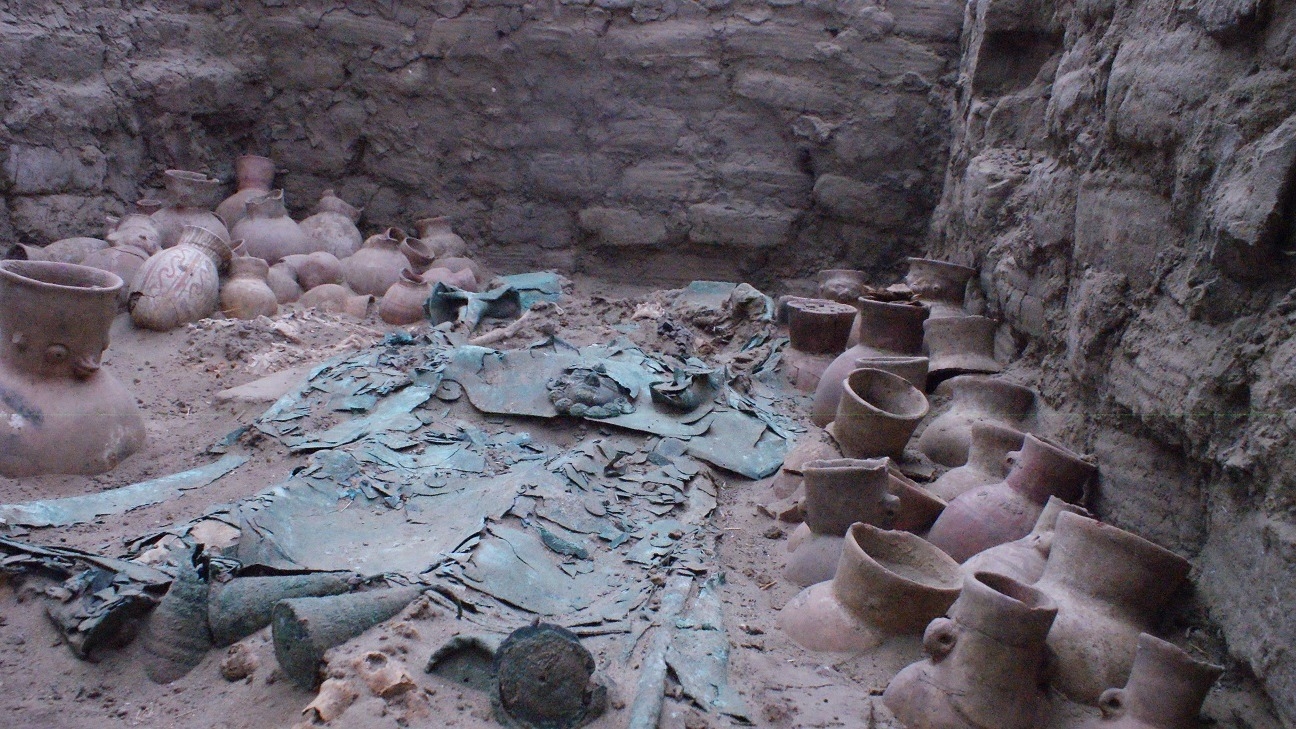
An excavation in Chiclayo, northern Peru, has unearthed three richly outfitted tombs of elite members of the Moche culture. Archaeologists from the Tumbas Reales de Sipan Museum discovered the tombs in Huaca of El Pueblo de Ucupe, the archaeological complex where the tomb of a high-ranking individual dubbed the Lord of Ucupe was discovered in 2009. The team returned to the site in December to do a follow-up dig.

The tombs are made of adobe brick and are different sizes. They date to the middle Moche period, around 600 to 700 A.D., and were later modifications to an earlier religious complex.

The first burial chamber was damaged by a sequence of heavy rain events that destroyed part of the funerary complex. The skeletons of one adult, probably female, and one child were found inside, their burial bundles covered with cinnabar which had ritual significance for the Moche. Grave goods include copper crowns, head/hairbands and breastplates and several ceramic objects, most notably three highly sculptural pottery vessels. One of them depicts a snail, another a man sitting on a throne, the third an explicit erotic scene.

From the early period of Moche civilization in the 2nd century, pottery production was exceptionally varied. There were practical forms and decorative ones which depicted a wide panoply of people, animals, activities and aspects daily life. Preferred motifs included crafts, war and 𝑠e𝑥. Of the 𝑠e𝑥 acts captured in Moche ceramics, hetero𝑠e𝑥ual anal 𝑠e𝑥 is the most frequently depicted.
The second tomb was created by dismantling an early period Mochica wall to build a funerary enclosure 6.5 feet long by five feet wide. One person, an adult male, was buried in this tomb alongside a camelid believed to have been a llama. There were a great many grave goods buried with him. He was garbed in copper plate with copper crowns and headbands and more than 50 pottery vessels with very finely worked and decorated sculptural bottles.

The third tomb is a large chamber with adobe walls. It had a roof made of wooden beams which has disintegrated over time. In the space underneath the roof, archaeologists initially found a human skull and one ceramic vessel. When the team reached the level where the funerary bundle was placed, they found more than 150 pottery vessels arranged in three groups and the remains of another camelid. The body of the deceased was placed on a wooden platform supported by bricks. The platform has rotted away, but his splendid adornments — a crown, two headbands, a plate dress, two earplugs, a nosepiece, two clubs, two banners and a funerary mask similar to the one found in the Lord of Ucupe’s tomb — survive.
The two burials with full sets of copper attire and accessories indicate these were individuals of high status and they were laid to rest with the emblems and regalia of their rank and command.
“These findings will allow us to establish the origins, development and links of the Mochicas in the Zaña Valley, with Sipán in the Lambayeque Valley and with the development of this town in the Jequetepeque Valley. The style of the archaeological assets seems to present a certain sequential order within the stage known as Moche Medio,” explained the project director, Walter Alva Alva.





